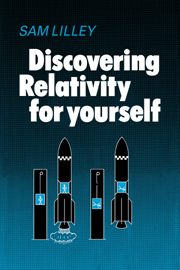Book contents
- Frontmatter
- Contents
- Preface
- Introduction
- 1 Getting started
- 2 Rough and ready Relativity
- 3 The dilation of time
- 4 Three clocks and a pair of twins
- 5 Starting again
- 6 Space–time diagrams
- 7 Time and distance ‘over there’
- 8 Co-ordinate systems
- 9 Combining speeds
- 10 Causality and the speed of light
- 11 The nature of spacetime
- 12 Interval
- 13 Old friends revisited
- 14 The scales of the spacetime diagram
- 15 The radar point of view
- 16 Relations between the radar and time–distance systems
- 17 Constant acceleration
- 18 Dynamics–mass, momentum, force
- 19 The mass–energy relation
- 20 The effect of acceleration on time measurement
- 21 Time as experienced by a constant acceleration traveller
- 22 Time and distance measurements of a constant acceleration observer
- 23 The Principle of Equivalence
- 24 The metric
- 25 Introducing geodesies
- 26 How to find ordinary geodesies
- 27 Inverse square law gravity
- 28 Curved spacetime
- 29 The metric around the Sun
- 30 Light and gravity
- 31 The scandal about Mercury
- 32 How Einstein did it
- 33 A few conclusions
- Index
- Frontmatter
- Contents
- Preface
- Introduction
- 1 Getting started
- 2 Rough and ready Relativity
- 3 The dilation of time
- 4 Three clocks and a pair of twins
- 5 Starting again
- 6 Space–time diagrams
- 7 Time and distance ‘over there’
- 8 Co-ordinate systems
- 9 Combining speeds
- 10 Causality and the speed of light
- 11 The nature of spacetime
- 12 Interval
- 13 Old friends revisited
- 14 The scales of the spacetime diagram
- 15 The radar point of view
- 16 Relations between the radar and time–distance systems
- 17 Constant acceleration
- 18 Dynamics–mass, momentum, force
- 19 The mass–energy relation
- 20 The effect of acceleration on time measurement
- 21 Time as experienced by a constant acceleration traveller
- 22 Time and distance measurements of a constant acceleration observer
- 23 The Principle of Equivalence
- 24 The metric
- 25 Introducing geodesies
- 26 How to find ordinary geodesies
- 27 Inverse square law gravity
- 28 Curved spacetime
- 29 The metric around the Sun
- 30 Light and gravity
- 31 The scandal about Mercury
- 32 How Einstein did it
- 33 A few conclusions
- Index
Summary
You may well be wondering whether this book is going to be too difficult for you. You may have special worries about whether you can cope with the mathematics that features rather prominently in the later pages. So let me assure you that this is a book for people who, when they start on it, are acquainted with arithmetic and nothing more. I undertake to teach you all the mathematics you need as you need it. If my assurance is not enough (and why should it be?), please read at least to page 4 before deciding whether to carry on or not.
The Special and General Theories of Relativity
But first of all, what is this Theory of Relativity? It is divided into two parts. By far the more important of these is the Special Theory of Relativity, which is roughly speaking the theory of how the world would appear to people who were used to moving around at very high speeds. And it must be steady motion–no speeding up, slowing down or swerving is permitted.
This Special Theory starts from the very simple idea that there is no means of knowing whether you are really moving or not. Not much in that, you would think. But when you follow up the consequences of this apparently innocent beginning, they turn out to be shattering. The world, says Relativity, is decidedly different from what we have hitherto believed.
Suppose (to take the most staggering assertion of the lot) that a pair of twins separate, one staying on Earth, the other going on a long fast space journey and returning.
- Type
- Chapter
- Information
- Discovering Relativity for Yourself , pp. 1 - 8Publisher: Cambridge University PressPrint publication year: 1981



